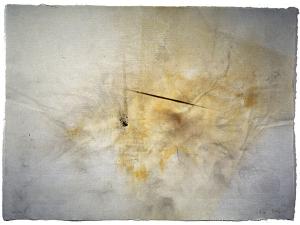John Cage
American composer and music theorist (1912–1992)
| Background information | |
|---|---|
| Birth name | John Milton Cage Jr. |
| Also known as | |
| Born | 1912-09-05 Los Angeles, California, U.S. |
| Origin | |
| Died | August 12, 1992 (aged 79)
|
| Genres | |
| Occupation(s) | Composer, music theorist, artist, philosopher |
| Instrument(s) | |
John Milton Cage Jr. (September 5, 1912 – August 12, 1992) was an American composer, music theorist, artist, and philosopher. A pioneer of indeterminacy in music, electroacoustic music, and non-standard use of musical instruments, Cage was one of the leading figures of the post-war avant-garde. Critics have lauded him as one of the most influential composers of the 20th century. He is perhaps best known for his 1952 composition 4′33″, which is performed in the absence of deliberate sound; musicians who present the work do nothing aside from being present for the duration specified by the title. The content of the composition is intended to be the sounds of the environment heard by the audience during performance.
Early life and education[edit | edit source]
John Cage was born in Los Angeles, California, to John Milton Cage Sr., an inventor, and Lucretia ("Crete") Harvey. Cage's paternal grandfather, Dr. Thomas Jefferson Cage, was a prominent figure in the field of education. Cage's early education was at Los Angeles High School, followed by two years at Pomona College.
Career[edit | edit source]
Cage's early compositions were written in a neoclassical style, but he soon began to experiment with atonality and serialism. In the late 1930s, he began to explore the use of percussion instruments and prepared piano, a piano that has had its sound altered by placing objects between or on its strings or hammers.
Indeterminacy and chance operations[edit | edit source]
In the 1950s, Cage began to use chance operations in his compositions, influenced by his study of Zen Buddhism and the I Ching. This approach led to works such as Music of Changes (1951) and Imaginary Landscape No. 4 (1951), which involve elements of randomness and unpredictability.
Later works and influence[edit | edit source]
Cage continued to compose and perform throughout his life, often collaborating with other artists, including Merce Cunningham, Robert Rauschenberg, and Jasper Johns. His later works include Cheap Imitation (1969) and Etudes Australes (1974–75). Cage's influence extends beyond music to the fields of visual art, dance, and literature.
Personal life[edit | edit source]
Cage was in a long-term relationship with choreographer Merce Cunningham, with whom he collaborated on numerous projects. He was also an avid mycologist and wrote several books on the subject.
Legacy[edit | edit source]
John Cage's work has had a profound impact on contemporary music and art. His ideas about the role of silence and the use of chance in composition have influenced generations of artists and composers. Cage's legacy continues to be celebrated through performances, recordings, and exhibitions of his work.
Related pages[edit | edit source]
Transform your life with W8MD's budget GLP1 injections from $125
W8MD offers a medical weight loss program NYC and a clinic to lose weight in Philadelphia. Our W8MD's physician supervised medical weight loss centers in NYC provides expert medical guidance, and offers telemedicine options for convenience.
Why choose W8MD?
- Comprehensive care with FDA-approved weight loss medications including:
- loss injections in NYC both generic and brand names:
- weight loss medications including Phentermine, Qsymia, Diethylpropion etc.
- Accept most insurances for visits or discounted self pay cost.
- Generic weight loss injections starting from just $125.00 for the starting dose
- In person weight loss NYC and telemedicine medical weight loss options in New York city available
- Budget GLP1 weight loss injections in NYC starting from $125.00 biweekly with insurance!
Book Your Appointment
Start your NYC weight loss journey today at our NYC medical weight loss, and Philadelphia medical weight loss Call (718)946-5500 for NY and 215 676 2334 for PA
Search WikiMD
Ad.Tired of being Overweight? Try W8MD's NYC physician weight loss.
Semaglutide (Ozempic / Wegovy and Tirzepatide (Mounjaro / Zepbound) available. Call 718 946 5500.
Advertise on WikiMD
|
WikiMD's Wellness Encyclopedia |
| Let Food Be Thy Medicine Medicine Thy Food - Hippocrates |
Translate this page: - East Asian
中文,
日本,
한국어,
South Asian
हिन्दी,
தமிழ்,
తెలుగు,
Urdu,
ಕನ್ನಡ,
Southeast Asian
Indonesian,
Vietnamese,
Thai,
မြန်မာဘာသာ,
বাংলা
European
español,
Deutsch,
français,
Greek,
português do Brasil,
polski,
română,
русский,
Nederlands,
norsk,
svenska,
suomi,
Italian
Middle Eastern & African
عربى,
Turkish,
Persian,
Hebrew,
Afrikaans,
isiZulu,
Kiswahili,
Other
Bulgarian,
Hungarian,
Czech,
Swedish,
മലയാളം,
मराठी,
ਪੰਜਾਬੀ,
ગુજરાતી,
Portuguese,
Ukrainian
Medical Disclaimer: WikiMD is not a substitute for professional medical advice. The information on WikiMD is provided as an information resource only, may be incorrect, outdated or misleading, and is not to be used or relied on for any diagnostic or treatment purposes. Please consult your health care provider before making any healthcare decisions or for guidance about a specific medical condition. WikiMD expressly disclaims responsibility, and shall have no liability, for any damages, loss, injury, or liability whatsoever suffered as a result of your reliance on the information contained in this site. By visiting this site you agree to the foregoing terms and conditions, which may from time to time be changed or supplemented by WikiMD. If you do not agree to the foregoing terms and conditions, you should not enter or use this site. See full disclaimer.
Credits:Most images are courtesy of Wikimedia commons, and templates, categories Wikipedia, licensed under CC BY SA or similar.
Contributors: Prab R. Tumpati, MD








